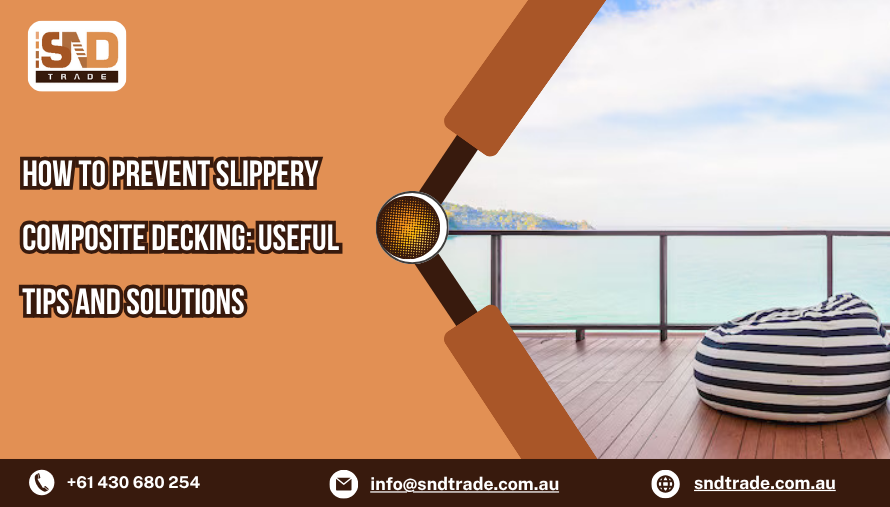One of the most important things to consider when building or renovating an outdoor deck is safety. Among the most common choices for contemporary outdoor living is composite decking. However, even the top-notch planks may turn out to be slick if not selected and maintained properly.
If you need professional help, SND Trade, the best composite decking installers Melbourne, can share some expert tips.
Here’s the guide that showcases the conditions under which composite decking can become slippery, and provides the right approach for securing the area throughout the year.
Why can composite decking become slippery?
Composite decking boards are made by mixing wood fibres, plastics, and bonding agents to create a product that resembles wood but has less maintenance. Nonetheless, not all composite boards have the same performance, especially in wet and humid environments.
The following factors can mainly cause the deck to be slippery:
- Flat, smooth surfaces: The early versions of composite decks had smooth plastic coverings or minor coating textures that had very little grip when soaked.
- Moisture, mould, and algae growth: The best boards can still have serious problems if the leaves, dirt, or water cause organic growth. The friction can go down enormously when mould or algae are developed.
- Poor drainage or ponding: The surfaces of the boards may become slippery if water is collected or if it runs underneath through blocked joists and gaps.
- Wear or poor surface texture: Board surface traction may diminish as boards get older, or if you choose cheaper options without textured finishes.
- Wet conditions: Wet surfaces are more dangerous. Even the best-quality textured composite boards may feel slippery in comparison with a dry surface.
In a nutshell, not all composite decking is slippery by nature, but there are a lot of factors (moisture, quality of the deck, debris) that need to be controlled to ensure safety.
Practical tips to keep your composite deck safe
Here are clear, actionable steps you can take to ensure your composite outdoor space remains safe and secure for everyone.
-
Choose the right boards from the start
- When planning your deck with your composite decking installers Melbourne homeowners trust, look for decking boards that claim to have textured surfaces, grooves or anti-slip finishes. Nowadays, high-quality composite decking boards come with integrated traction features.
- Don’t just consider the looks in making your decision. Inquire about the results of slip tests (e.g., coefficient of friction or Pendulum Test Value) where available. A certain provider states that contemporary boards received “low slip” ratings even when moist.
- Make sure your installation has adequate drainage (gap between boards, sloped away from the house) so that the water does not accumulate.
-
Keep the deck clean and free of debris
- Periodically remove leaves, pine needles and other waste either by sweeping or using a blower. When organic material sits on the boards, the boards’ surface becomes a breeding ground for mould and algae, which reduces traction.
- Once or twice yearly, do a more thorough cleaning by using a solution of mild soap and water—stay away from harsh chemicals unless they are indicated as safe for your product.
- In moist or shaded locations (in Melbourne or other Australian regions), often inspect for the presence of green film or dark patches, and conduct cleaning immediately.
-
Manage moisture and drainage effectively
- It is necessary for the deck to have a slight slope (generally around 1 in 100) to promote runoff instead of pooling.
- Inspect the substructure: there should be no obstruction between the boards, joists should allow airflow and bushes or trees that overhang and trap moisture should be trimmed.
- After the rain or shower (especially if your deck is next to a pool or spa), excess surface water should be cleared off with a broom or a squeegee.
-
Add extra traction if needed
- In case your deck surface still seems to be too smooth when wet (especially old boards), think of non-slip coatings or treatment strips. There are clear coatings that keep the visual finish intact while providing grip.
- Outdoor textured mats or grip strips can be placed at doorways, stairs, or pool-adjacent areas to improve safety.
- Wearing the right shoes should be encouraged when the deck area is used during humid or wet conditions.
-
Schedule regular inspections and maintenance
- Check periodically for algae, mould or discolouration and treat as soon as detected.
- Do not resort to ice (if applicable) or debris removal with metal shovels or abrasive tools, as these methods may ruin the surface and lessen grip.
- If the water is still collected, consult your composite decking Melbourne installer to check the sub-surface drainage and correct anything that can become a problem later on.
Conclusion
Australian homeowners looking for a no-fuss and fashionable outdoor space, composite decking has a lot of advantages; nevertheless, safety is the primary concern. If one chooses well-designed boards with textured surfaces, uses quality composite decking boards, and maintains your deck through regular cleaning, drainage control, and traction enhancement, then the risk of slipping will be greatly reduced.
Are you prepared to make your deck both safe and inviting? Get in touch with SND Trade, the best composite decking installers Melbourne right now. Find out the best composite decking boards for your area and make sure they are installed with the proper drainage and slip-resistance features. Live your outdoor life with a worry-free mind!

